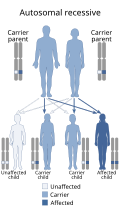Progeroid syndromes
Progeroid syndromes (PS) describes a range of genetic disorders where the affected person appears to grow older faster.[1] All these disorders are monogenetic,[2] meaning they come from mutations of a single gene. Most known PS mutations lead to either defects in the DNA repair mechanism, or defects in a protein known as lamin A/C.
Progeroid means "resembling old age". This definition can be applied to many different diseases. Alzheimer's disease and Parkinson's disease affects only one tissue. In most cases, the term progeroid syndrome is used for cases where the affected people only show some of the features of aging, but not all of them. In these cases, many different kinds of tissue are affected.
Individuals with PS-related disorders often have a reduced lifespan.[2] The most widely studied of the progeroid syndromes are Werner syndrome (WS) and Hutchinson-Gilford Progeria Syndrome (HGPS), because they resemble natural aging.[2]
Because of its property of accelerated aging (senescence), progeroid syndomes have been widely studied in the fields of aging,regeneration, stem cells and cancer.[2]
Progeroid Syndromes Media
An eight-year-old girl from Guatemala with xeroderma pigmentosum. Children with XP are often colloquially referred to as Children of the Night.
Lamin is required at the inner nuclear membrane to ensure the nucleus keeps its shape. Mutations in LMNA causes dysfunctional lamin, and the nucleus can no longer keeps its shape. This leads to mislocalisation of heterochromatin, which normally lie in close proximity, or with, the nuclear matrix, nuclear blebbing and misregulation of gene expression.
Girl with HGPS (left). This condition is caused by dysfunctional lamin which is unable to maintain the nuclear shape (normal at top, abnormal at bottom).
References
- ↑ Navarro, Claire L.; Cau, Pierre; Lévy, Nicolas (2006). "Molecular bases of progeroid syndromes". Human Molecular Genetics. 15: R151–R161. doi:10.1093/hmg/ddl214. PMID 16987878.



